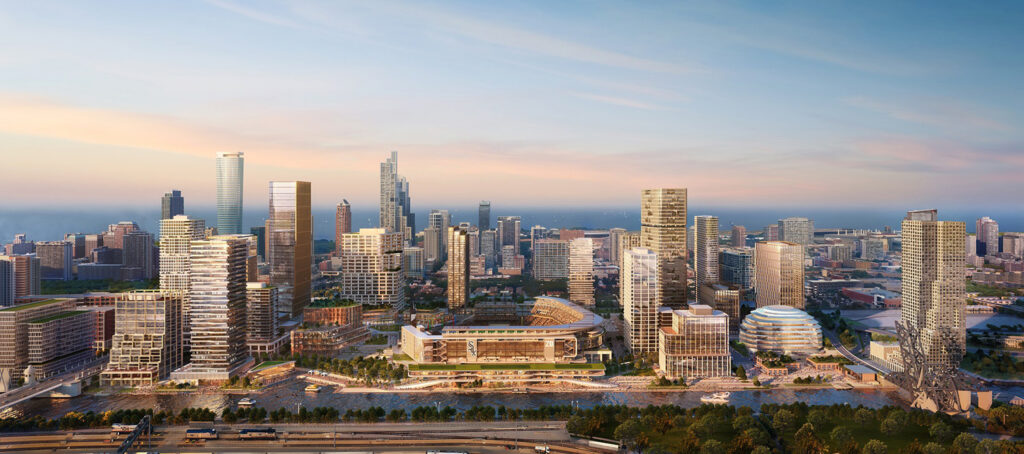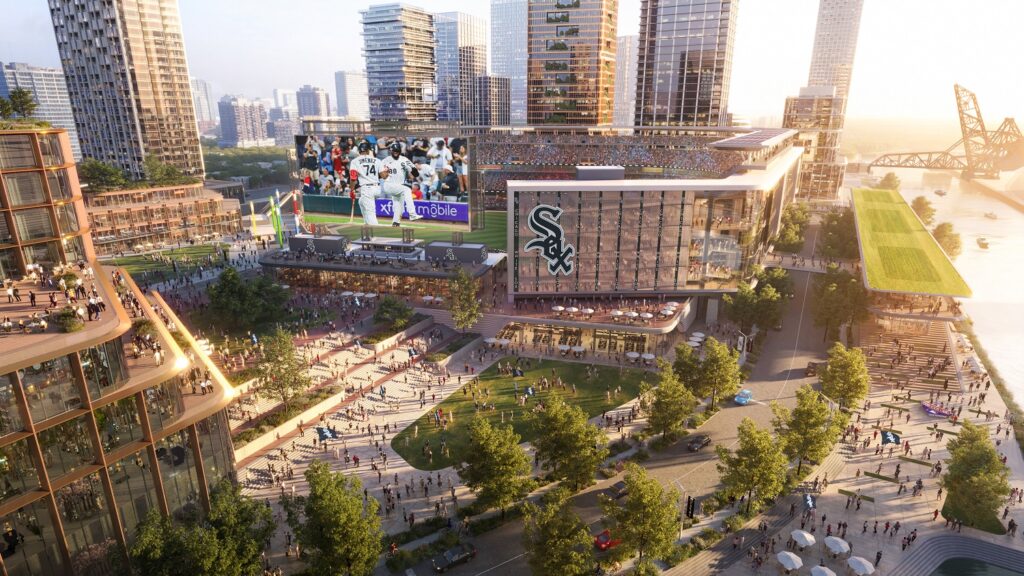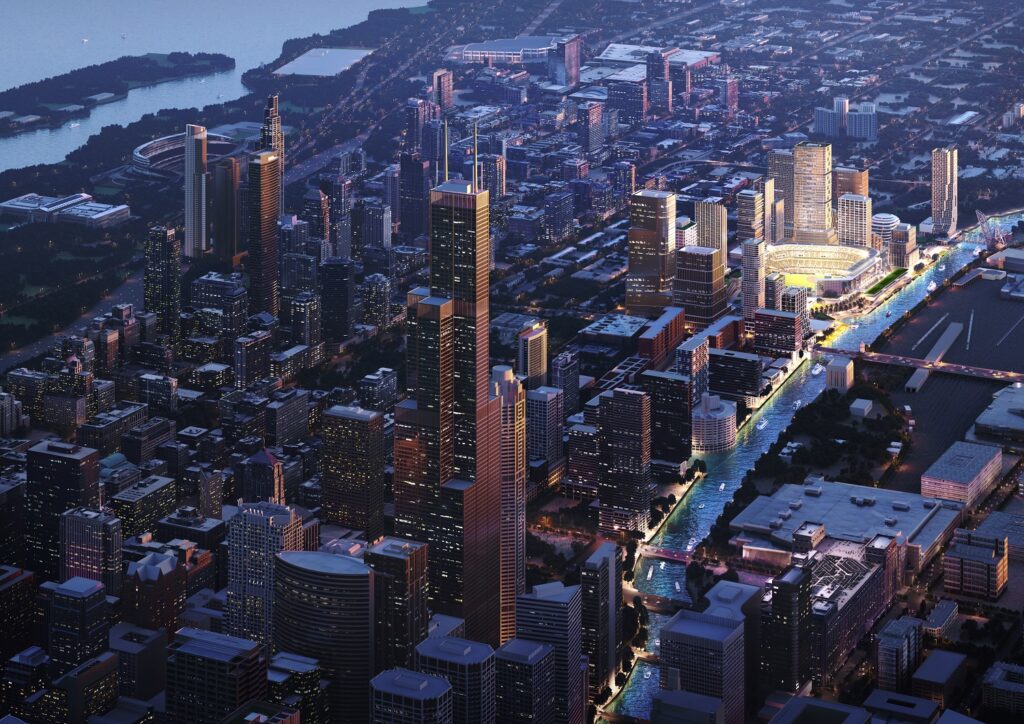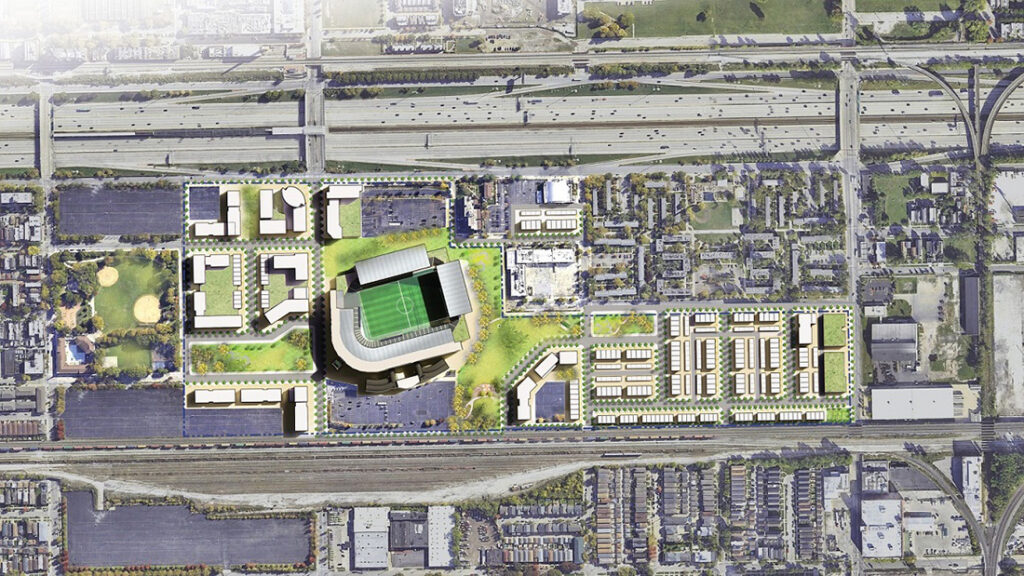
A new Chicago White Sox ballpark could be part of a dramatic realignment of sporting facilities in the Windy City, as the team mulls a move to The 78 South Loop development near Clark Street and Roosevelt Road.
That a new ballpark emerged as a possibility for The 78 is a little surprising: developer Related Midwest isn’t known for sports facilities, but rather affordable housing and cutting-edge research facilities. Billed as potentially Chicago’s 78th neighborhood, The 78 is a 62-acre development advertised as a mixture of housing, cultural events, academia, sports and entertainment and outdoor recreational spaces. It’s been the centerpiece for assorted development plans in recent years, including one proposal for a casino development.
That the White Sox are debating a move from Guaranteed Rate Field isn’t a surprise: owner Jerry Reinsdorf confirmed the team was shopping for a new home when the Guaranteed Rate Field lease ends after the 2029 season. Opening in 1991, the former Comiskey Park and U.S. Cellular Field was financed and built by the Illinois Sports Facilities Authority and designed in a traditional layout. Located next to the original Comiskey Park, the ballpark had some definite design flaws—seats were located far off the action and the upper-deck incline was too steep for many fans—and had the misfortune of being the last traditional ballpark opening before the emergence of Oriole Park at Camden Yards. The home of the Baltimore Orioles immediately impacted ballpark design across the majors and minors, and although modernism made a comeback in recent years with the opening of Target Field and a proposal for a new Kansas City Royals ballpark, retro ballpark designs are still popular with fans.

Details of a new Chicago White Sox ballpark
But the design wasn’t the only issue with Guaranteed Rate Field: it was located on the old Comiskey Park parcel, which was largely given over to parking, not providing for any associated development in recent years even after The Battery changed the expectations of the modern ballpark experience. But that experience could take place at new Chicago White Sox ballpark, as Related Midwest foresees a mixed-use environment with 5,000 residential units (1,000 of them affordable), an office building, a hotel and plenty of restaurants, retail and bars taking advantage of riverfront views. Depending on the ballpark configuration, part of the new ballpark seating could have a scenic view of the downtown Chicago skyline, as seen in some of these renderings from Gensler and Related Midwest. (Another credit: the ballpark design comes from HOK.)

The White Sox are looking at a ballpark seating between 35,000 to 38,000, sitting on 12 to 14 acres. The South Loop location features CTA Red, Green and Orange line service at the nearby Roosevelt station, while we could also see water-taxi service on the Chicago River. And, of course, there’s plenty of local street and freeway access.
We are still in early discussions of what a new Chicago White Sox ballpark and associated development entails and, most importantly, any funding. It’s hard to see the Illinois Sports Facilities Authority not be involved, but with an anticipated price tag exceeding $1 billion, it might take a little imagination and meaningful participation of the White Sox to make a deal work.

What becomes of Guaranteed Rate Field?
Jerry Reinsdorf has never been a big fan of development at Guaranteed Rate Field, even though there’s plenty of land on the 70 acres of surface parking—with the White Sox receiving all parking revenue, there’s never been an inventive for him to give up one single spot.
But if the White Sox relocate to the South Loop, that presents some issues to the Illinois Sports Facilities Authority, which still has to manage some $50 million on ballpark bonding. The solution being floated now: convert the ballpark into a home for the MLS Chicago Fire, probably by downsizing seating and opening one end of the ballpark to accommodate a full pitch. But the move of the Fire, who currently play at Soldier Field, and maybe NWSL’s Chicago Red Stars, would also allow development of the 70 acres of parking. That possibility is also foreseen by Related Midwest and Gensler, as shown in the renderings below.


And if both the Fire and the Chicago Bears end up departing the South Loop, what becomes of Soldier Field? It’s always been an awkward fit in Chicago’s cultural campus. A scaled-back amphitheater, however, could be seen as a positive addition to a cultural campus. As we noted in the top of this article, a new Chicago White Sox ballpark could be part of a dramatic realignment of sporting facilities in the Windy City—with four professional teams housed in new venues by 2030.
